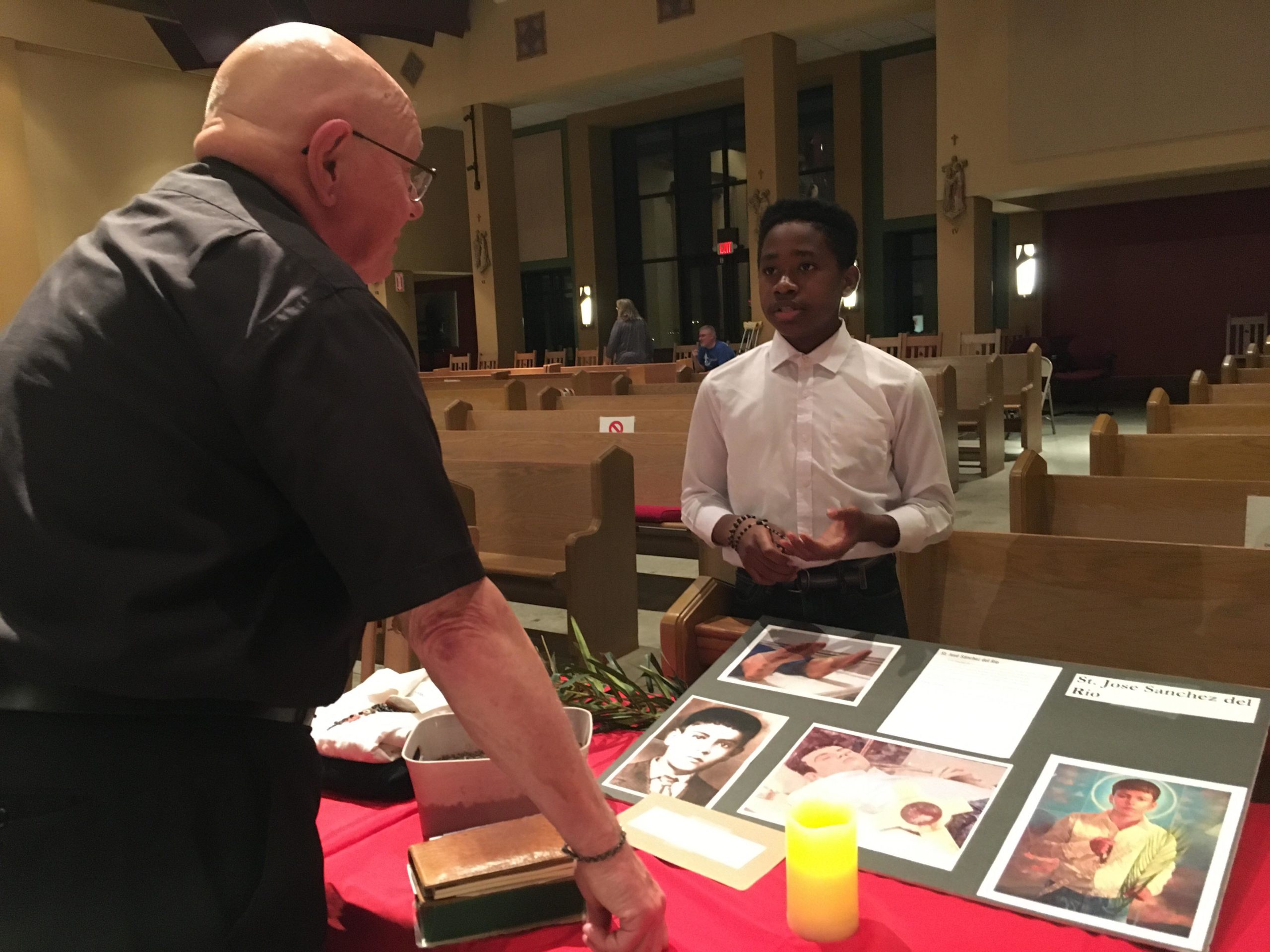
Dcn. Rich Stanula speaks with Robert-Gil Gabila Gwankobe at the Martyrs Museum at St. Anne in Pleasant Prairie. (Photo by Karen Mahoney)
It is the cause, not the death, that makes a martyr. With the rampant persecution of Christians worldwide, how do we know if someone is a martyr or simply a victim of a violent attack?
In a talk Friday, Oct. 1, Fr. Robert Weighner, pastor of St. Anne Parish in Pleasant Prairie, explained that a martyr is someone who freely gives their life for Christ.
“In the first 300 years of our faith, to be a practicing Catholic meant you were ready to die,” he said. “Martyrdom was a reality people were ready to face in their day-to-day faith.”
Fr. Weighner’s talk was the opening for the parish’s youth group, Quo Vadis, to present their Martyr Museum, where 30 students each studied a martyr of the Church and prepared a discussion and display for visitors. Some of the martyrs included St. Stephen, St. Sebastian, St. Maximillian Kolbe, The Holy Innocents, St. Ignatius of Antioch, St. Jose Sanchez del Rio, St. Cecilia, St. Margaret Clitherow, St. Cassian, St. Peter, St. Philomena, The Ugandan Martyrs, St. Maria Goretti, Blessed Dario Acosta, St. Bartholomew, St. Teresa Benedicta of the Cross and St. John Nepomuk.
Fr. Weighner explained the martyrs shared in one commonality: each had the power to escape death but freely gave their lives for Christ.
The director of Quo Vadis, Richard Sosa, said the idea developed from his unique way to reach out to the middle and high school youth’s study on martyrs. After learning about them, one of the students suggested they present the martyr museum for the parish.
“We wanted to bring the life of the martyr to inspire us,” Sosa said. “These are turbulent times right now. You never know when you will come to that moment when God is going to ask you to be a martyr — when you have to make that choice. All these martyrs had a choice. They could have renounced their faith. They could have run. But they said no, ‘Viva Cristo Rey. Glory to God. Forgive them, for they know not what they do.’ They willingly went through with their destiny to glorify God.”
Depicting St. Jose Sanchez del Rio, Robert-Gil Gabila Gwankobe, 13, explained that the young martyr asked God to allow him to die in defense of the Church after visiting the tomb of a martyr. A year later, God answered his prayer, and he was killed for the faith just a month shy of his 15th birthday.
“He had a strong love for God, and he was captured during a battle and imprisoned. His godfather had ordered his assassination,” said Gwankobe. “He was put in prison, and on Feb. 10, 1928, he was tortured, and they peeled the skin off the bottom of his feet. He had to walk on salt, and then they forced him to walk a mile to his grave. Along the way, the soldiers told him they would let him go if he denied his faith, but he shouted, ‘Long live Christ the King,’ and was shot.”
Lee-Ann Nabila Lev-Songwe, 15, chose St. Teresa Benedicta of the Cross (Edith Stein). She admired her devotion to St. Teresa of Avila and her advocacy for women’s rights and politics.
“She was Jewish and born into a pagan family, but she later began her Catholic faith journey. She visited a friend who was more religious than she was, and that’s when her friend gave her a book by St. Teresa of Avila and she was captivated by it,” she said. “That made her want to become a Carmelite nun. She joined with her sister, Rosa. During that time, the Nazis took over. She was arrested because she was Jewish and brought into Auschwitz.”
While imprisoned, St. Teresa Benedicta held small prayer gatherings and encouraged others to believe in God. Despite being in the concentration camp, she remained a positive influence on others.
“Auschwitz was a really scary place, and no one wanted to go there, of course. Her sister was scared and didn’t want to go because she had heard stories about how horrible it was,” Lev-Songwe said. “But St. Teresa Benedicta said to her sister, ‘Come, let’s go die for our people. For God’s people.’ She found that this was what God called her to do. On Aug. 2, 1942, she was gassed and cremated, and was canonized by Pope John Paul II on Oct. 11, 1998.”
When Synjin Palacio began studying St. Tarcisius, an acolyte, he was shocked to learn the saint became a martyr at age 12, the same age he is now.
“He was on a mission to deliver the Eucharist to a prisoner. Normally deacons did that, but there were no deacons to go and take it to them, so he volunteered, and on the way, he met a group of pagans and got beaten up and stoned,” said Palacio. “He was brave. I don’t know if I could do that. When he died, he held the Eucharist to his heart so tightly (during the beating), they had to pry it out of his hands after he was dead.”
